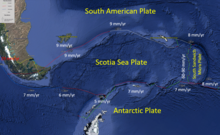| South Sandwich plate | |
|---|---|
 | |
| Type | Micro |
| Approximate area | 170,000 km2[1] |
| Movement1 | East |
| Speed1 | 47mm/year |
| Features | South Sandwich Islands, Southern Ocean |
| 1Relative to the African plate | |


The South Sandwich plate or the Sandwich plate is a small tectonic plate (microplate) bounded by the subducting South American plate to the east, the Antarctic plate to the south, and the Scotia plate to the west. The plate is separated from the Scotia plate by the East Scotia Rise, a back-arc spreading ridge formed by the subduction zone on its eastern margin. The South Sandwich Islands are located on this microplate.
The initiation of the South Sandwich subduction zone, a convergent plate margin, began around 66 Ma in response to regional convergence of the Antarctic and South American tectonic plates. Gradual extension of the Scotia Sea and subduction roll back of South American oceanic lithosphere created the ancestral Scotia plate. The South Sandwich Microplate separated from the Scotia plate around 15 Ma as a back arc basin formed with development of the East Scotia Rise. There is continued debate over the reason for the separation of the South Sandwich plate from the Scotia plate. Two primary mechanisms have been proposed, subducting slab roll back and absolute motion of the Scotia plate away from the trench. A combination of these two mechanisms could also contribute to the current plate boundary configurations.[2]
- ^ "Sizes of Tectonic or Lithospheric Plates". 2014-03-05. Retrieved 2016-05-15.
- ^ van de Lagemaat, Suzanna H. A.; Swart, Merel L. A.; Vaes, Bram; Kosters, Martha E.; Boschman, Lydian M.; Burton-Johnson, Alex; Bijl, Peter K.; Spakman, Wim; van Hinsbergen, Douwe J. J. (2021-04-01). "Subduction initiation in the Scotia Sea region and opening of the Drake Passage: When and why?". Earth-Science Reviews. 215: 103551. doi:10.1016/j.earscirev.2021.103551. hdl:20.500.11850/472835. ISSN 0012-8252.